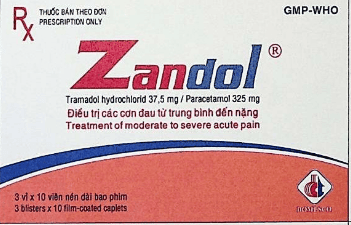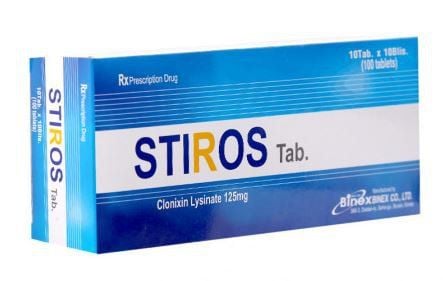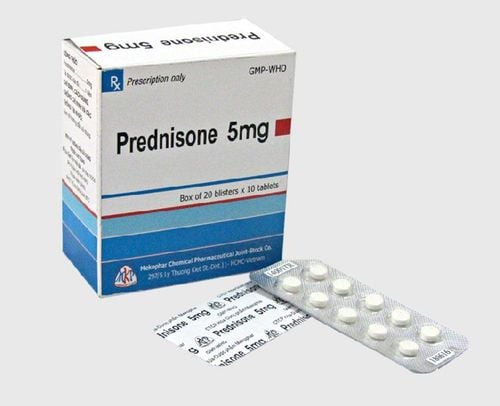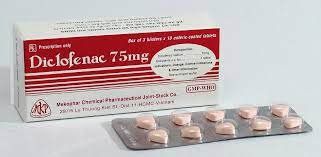This is an automatically translated article.
Diclofenac or diclofenac sodium is often used to treat chronic arthritis with the main effect of reducing swelling and reducing inflammation. So what is diclofenac? The following article will help you know the uses and uses of diclofenac.1. Description of the drug diclofenac sodium
Diclofenac is a medicine used to treat pain, swelling, and pain caused by many conditions, including arthritis, menstrual cramps, migraines, and others.This medicine comes in many formulations and brands, is used for specific purposes, and may contain different amounts of the drug. For example, the powder (Cambia) form of diclofenac is used to treat migraines. It also comes as a topical treatment, commonly used for musculoskeletal pain.
US brands include: Cambia; Cataflam; Voltaren; Voltaren-XR; Zorvolex
1.1. What is Diclofenac? Diclofenac is a nonsteroidal anti-inflammatory drug (NSAID) used to treat mild to moderate pain and to help relieve symptoms of arthritis (e.g., osteoarthritis or rheumatoid arthritis) such as inflammation, swelling, and inflammation. , stiffness and pain in joints. This medicine does not cure arthritis and will only help you as long as you keep taking it.
This medication is also used to treat ankylosing spondylitis, which is a type of arthritis that affects the joints in the spine, and other painful conditions such as menstrual cramps. Diclofenac is also used to treat acute migraine attacks, with or without aura, in adults. It will not prevent or reduce the number of migraine attacks.
This medicine is to be used only with a doctor's prescription.
1.2. Diclofenac drug forms This product is available in the following dosage forms:
25 mg, 50 mg, and 100 mg tablets. Syringe 75 mg/2 ml; and 75 mg/3 ml. 25 mg and 100 mg suppositories. Drops 0.1%. Gel for external use 10 mg/g.
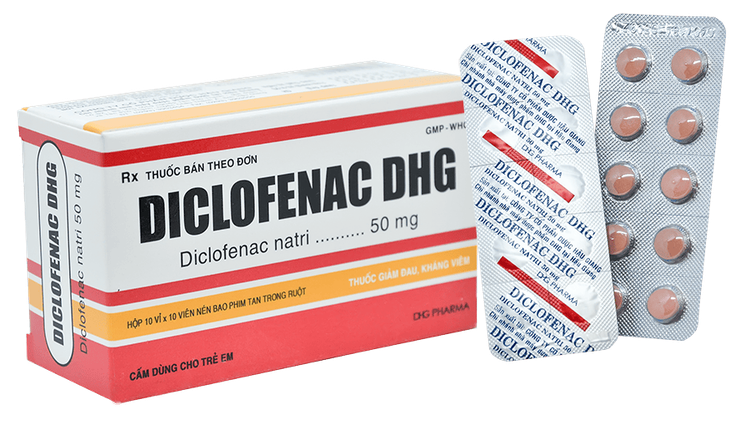
Thuốc Diclofenac được bào chế ở dạng viên nén và một số dạng bào chế khác nhau
1.3. Some characteristics of diclofenac dosing characteristics Usual adult dose for osteoarthritis:
Diclofenac free acid capsules: 35mg orally 3 times a day Diclofenac potassium immediate-release tablets: 50 mg, orally 2 or 3 times a day Diclofenac enteric-coated tablets: 50 mg orally 2 or 3 times a day or 75 mg orally 2 times a day Maximum dose: 150 mg daily Diclofenac sodium extended-release tablet: 100 mg orally once a day Uses: Used to relieve the signs and symptoms of osteoarthritis. Usual adult dose for ankylosing spondylitis: Diclofenac enteric-coated, slow-release tablets: 25 mg orally 4 times a day. An additional dose of 25 mg may be given at bedtime, if needed Maximum dose: 125 mg daily Use: Acute or long-term use for the relief of signs and symptoms of ankylosing spondylitis. Usual Adult Dose for Dysmenorrhea:
Diclofenac Potassium Instant Release Tablets: 50 mg orally 3 times a day Comments: An initial dose of 100 mg orally followed by 50 mg orally may provide better pain relief. for some patients; Start treatment at the first appearance of symptoms and continue for several days. Use: For the relief of signs and symptoms of primary dysmenorrhea. Usual Adult Dose for Rheumatoid Arthritis: Diclofenac immediate-release potassium tablet: 50 mg orally 3 or 4 times a day Diclofenac sodium enteric-coated tablet and delayed-release tablet: 50 mg orally 3 to 4 times a day or 75 mg orally twice a day Maximum dose: 225 mg daily Diclofenac sodium extended-release tablets: 100 mg orally once a day Maximum dose: 100 mg orally 2 times a day; this would be for the rare patient where the benefits outweigh the clinical risks. For relief of signs and symptoms of rheumatoid arthritis Usual Adult Dose for Migraine:
Diclofenac potassium for oral solution sachet: 50 mg (1 sachet) orally once a day Comments: This medicine is not indicated for migraine prophylaxis or for use in episodic headaches; Safety and efficacy with a second dose have not been established. Use: Acute treatment of migraine with or without aura. Usual Adult Dose for Pain Relief:
Oral:
Diclofenac potassium-filled liquid capsule: 25 mg, taken 4 times a day Diclofenac free acid capsules: 18 mg or 35 mg orally 3 times a day Diclofenac tablets instant potassium release: 50 mg, orally 3 times a day; An initial dose of 100 mg orally followed by 50 mg orally may provide better pain relief for some patients.

Người bệnh không nên tự ý sử dụng thuốc diclofenac khi chưa được tư vấn
Parenteral:
37.5 mg IV over 15 seconds every 6 hours as needed for pain Maximum dose: 150 mg daily Note: Patients should be adequately hydrated prior to IV administration of this medication to reduce the risk of adverse reactions to the kidneys. Uses: Treatment of mild to moderate acute pain (oral, IV) and moderate to severe pain alone or in combination with opioid (IV) analgesics. What happens if I miss a dose?
Take that dose as soon as you remember. Skip the missed dose if it is almost time for your next scheduled dose. Do not take extra medicine to make up the missed dose.
Undesirable effects Diclofenac
5 - 15% of patients have side effects in the gastrointestinal tract. Adverse effects are similar to those of ibuprofen, but with a higher incidence.
2. Some tips when using diclofenac
2.1. Warnings when using diclofenac You should not take diclofenac if you have a history of allergy to aspirin or non-steroidal anti-inflammatory drugs.
Diclofenac can increase your risk of fatal heart attack or stroke, especially if you use it long-term or take high doses, or if you have heart disease. This medicine must not be used right before or after bypass surgery (coronary artery bypass graft, or CABG).
Diclofenac can also cause stomach or intestinal bleeding, which can be fatal. These conditions may occur without warning while you are using this medicine, especially in older adults.
Before taking this medicine : Diclofenac may increase your risk of fatal heart attack or stroke, even if you do not have any risk factors. This medicine should not be used right before or after bypass surgery (coronary artery bypass graft).
Diclofenac can also cause stomach or intestinal bleeding and can be fatal. You also should not use diclofenac if you are allergic to it, or if you have ever had an asthma attack or severe allergic reaction after taking aspirin or a nonsteroidal anti-inflammatory drug.
Cambia should not be used to treat cluster headaches and do not use Zipsor if you are allergic to beef or beef protein.
To make sure this medicine is safe for you, tell your doctor if you have:
Heart disease, high blood pressure ; Ulcers or bleeding in your stomach; Asthma ; Liver or kidney disease; or If you smoke.

Người mắc bệnh huyết áp cao nên báo với bác sĩ trước khi dùng thuốc Diclofenac
Diclofenac can affect ovulation and it may be more difficult to get pregnant while you are taking this medicine.
If you are pregnant, you should not use diclofenac unless your doctor tells you to. Taking nonsteroidal anti-inflammatory drugs during the last 20 weeks of pregnancy can cause serious heart or kidney problems in your unborn baby and possible complications with your pregnancy.
It may not be safe to breastfeed while taking this medicine. Ask your doctor about any risks. Diclofenac is not approved for use by anyone under the age of 18.
2.2. How should you take diclofenac? Use diclofenac exactly as prescribed by your doctor. Follow the directions on your medicine label and read all directions when taking your medicine. Your doctor will probably change your dosage from time to time. Take the lowest dose that is effective in treating your condition.
Different brands of diclofenac contain different amounts of diclofenac and may have different uses. If you switch brands, your dosage needs may change. Follow your doctor's instructions for how much medicine to take. Ask your pharmacist if you have any questions about the brand you get at the pharmacy.
Swallow the tablet whole and do not crush, chew or break the tablet.
Take Zorvolex on an empty stomach, at least 1 hour before or 2 hours after a meal.
Dissolve the powder form of this medicine (Cambia) with 1 to 2 ounces of water. Do not use any other liquid. Stir the mixture well and drink them all at once. Cambia works best if taken on an empty stomach.
Call your doctor if your headache does not go away completely after using Cambia.
If you use diclofenac long-term, you may need frequent medical tests.
Store at room temperature away from moisture and heat. Close the cap tightly when not in use.
Please dial HOTLINE for more information or register for an appointment HERE. Download MyVinmec app to make appointments faster and to manage your bookings easily.




